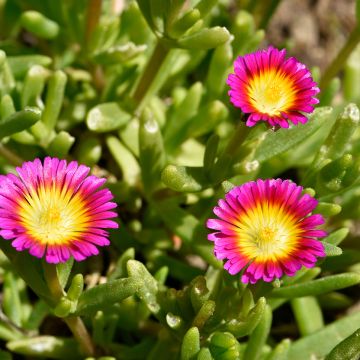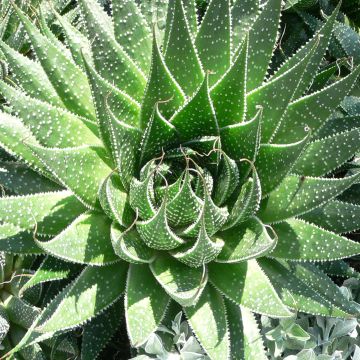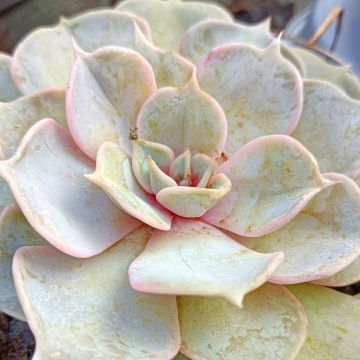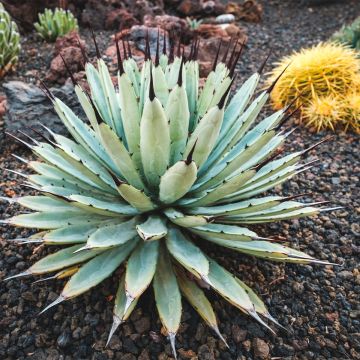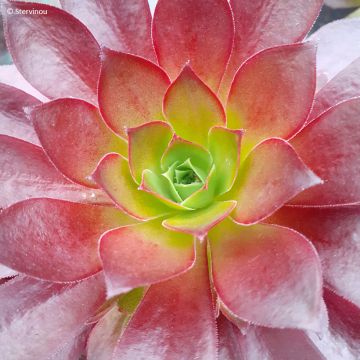

Crassula exilis subsp. schmidtii


Crassula exilis subsp. schmidtii


Crassula exilis subsp. schmidtii


Crassula exilis subsp. schmidtii
Crassula exilis subsp. schmidtii
Crassula exilis subsp. schmidtii
Crassule de Schmidt
Why not try an alternative variety in stock?
View all →This plant carries a 12 months recovery warranty
More information
We guarantee the quality of our plants for a full growing cycle, and will replace at our expense any plant that fails to recover under normal climatic and planting conditions.
From €5.90 for pickup delivery and €6.90 for home delivery
Express home delivery from €8.90.
Does this plant fit my garden?
Set up your Plantfit profile →
Description
The Crassula exilis subsp schmidtii is a small succulent plant native to South Africa that forms a bushy and creeping ground cover in poor, sandy or rocky soils. Its small green succulent leaves, tinged with red in the sun, highlight its long and delicate purple-pink flowering. Not very hardy, it is a plant easily grown in a pot for overwintering. Outdoors, in a coastal garden or protected from heavy frost, this discreet beauty tolerates drought and sea spray and looks wonderful above walls or in rockeries.
The Crassula exilis subsp schmidtii is a succulent perennial plant of the Crassulaceae family. Most species in the genus are native to South Africa, where they thrive in bright environments in well-drained, light soils that remain dry during winter. This species requires little watering as its fleshy leaves serve as storage during drier periods. The Crassula exilis is sometimes grown as an indoor plant because it cannot survive temperatures below -5°C (23°F) at its lowest. It should be brought indoors and protected from frost from late autumn onwards.
The Crassula exilis subsp schmidtii is a highly branched plant with fairly slow growth. It reaches a height of about 10-15 cm (4-6in) but spreads laterally through rooting stems that anchor into the ground. The stems are densely covered with round, fleshy, elongated, velvety leaves with a reddish underside. These dense leaves form a kind of rosette. The leaf blades sometimes turn pink in the sun. Flowering occurs from May to July on mature plants. It takes the form of short flower spikes, barely protruding from the foliage, bearing corymbs of tiny star-shaped flowers, pink to purple, measuring approximately 5 mm (1in) in diameter.
In mild coastal climates, it is possible to plant Crassula exilis subsp schmidtii in rockeries, above a wall or on a well-drained slope, alongside Cape Aster Felicia amelloides, Delospermas and purslanes that thrive in similar conditions. Elsewhere, you can plant it in a nice pot, alone or in combination with other succulent plants such as houseleeks.
Report an error about the product description
Flowering
Foliage
Plant habit
Botanical data
Crassula
exilis subsp. schmidtii
Crassulaceae
Crassule de Schmidt
South Africa
Other Cacti and succulents
Planting and care
Plant the Crassula exilis supsp Schmidtii in a pot or open ground in May. It should be planted in full sun or a very bright semi-shade in well-drained, light, sandy to rocky, poor, fairly dry soil. This succulent tolerates occasional frosts of around -5°C (23°F) in soil or substrate that is well-drained and remains perfectly dry in winter. Use succulent plant compost that is well-draining and not too poor: a mix of leaf compost, pumice, and turf or coco fibre would be ideal. Regular but moderate watering is necessary throughout the growing season, especially during summer and for potted plants.
Overwinter potted plants in a very bright, frost-free, but unheated room.
Planting period
Intended location
Care
This item has not been reviewed yet - be the first to leave a review about it.
Haven't found what you were looking for?
Hardiness is the lowest winter temperature a plant can endure without suffering serious damage or even dying. However, hardiness is affected by location (a sheltered area, such as a patio), protection (winter cover) and soil type (hardiness is improved by well-drained soil).

Photo Sharing Terms & Conditions
In order to encourage gardeners to interact and share their experiences, Promesse de fleurs offers various media enabling content to be uploaded onto its Site - in particular via the ‘Photo sharing’ module.
The User agrees to refrain from:
- Posting any content that is illegal, prejudicial, insulting, racist, inciteful to hatred, revisionist, contrary to public decency, that infringes on privacy or on the privacy rights of third parties, in particular the publicity rights of persons and goods, intellectual property rights, or the right to privacy.
- Submitting content on behalf of a third party;
- Impersonate the identity of a third party and/or publish any personal information about a third party;
In general, the User undertakes to refrain from any unethical behaviour.
All Content (in particular text, comments, files, images, photos, videos, creative works, etc.), which may be subject to property or intellectual property rights, image or other private rights, shall remain the property of the User, subject to the limited rights granted by the terms of the licence granted by Promesse de fleurs as stated below. Users are at liberty to publish or not to publish such Content on the Site, notably via the ‘Photo Sharing’ facility, and accept that this Content shall be made public and freely accessible, notably on the Internet.
Users further acknowledge, undertake to have ,and guarantee that they hold all necessary rights and permissions to publish such material on the Site, in particular with regard to the legislation in force pertaining to any privacy, property, intellectual property, image, or contractual rights, or rights of any other nature. By publishing such Content on the Site, Users acknowledge accepting full liability as publishers of the Content within the meaning of the law, and grant Promesse de fleurs, free of charge, an inclusive, worldwide licence for the said Content for the entire duration of its publication, including all reproduction, representation, up/downloading, displaying, performing, transmission, and storage rights.
Users also grant permission for their name to be linked to the Content and accept that this link may not always be made available.
By engaging in posting material, Users consent to their Content becoming automatically accessible on the Internet, in particular on other sites and/or blogs and/or web pages of the Promesse de fleurs site, including in particular social pages and the Promesse de fleurs catalogue.
Users may secure the removal of entrusted content free of charge by issuing a simple request via our contact form.
The flowering period indicated on our website applies to countries and regions located in USDA zone 8 (France, the United Kingdom, Ireland, the Netherlands, etc.)
It will vary according to where you live:
- In zones 9 to 10 (Italy, Spain, Greece, etc.), flowering will occur about 2 to 4 weeks earlier.
- In zones 6 to 7 (Germany, Poland, Slovenia, and lower mountainous regions), flowering will be delayed by 2 to 3 weeks.
- In zone 5 (Central Europe, Scandinavia), blooming will be delayed by 3 to 5 weeks.
In temperate climates, pruning of spring-flowering shrubs (forsythia, spireas, etc.) should be done just after flowering.
Pruning of summer-flowering shrubs (Indian Lilac, Perovskia, etc.) can be done in winter or spring.
In cold regions as well as with frost-sensitive plants, avoid pruning too early when severe frosts may still occur.
The planting period indicated on our website applies to countries and regions located in USDA zone 8 (France, United Kingdom, Ireland, Netherlands).
It will vary according to where you live:
- In Mediterranean zones (Marseille, Madrid, Milan, etc.), autumn and winter are the best planting periods.
- In continental zones (Strasbourg, Munich, Vienna, etc.), delay planting by 2 to 3 weeks in spring and bring it forward by 2 to 4 weeks in autumn.
- In mountainous regions (the Alps, Pyrenees, Carpathians, etc.), it is best to plant in late spring (May-June) or late summer (August-September).
The harvesting period indicated on our website applies to countries and regions in USDA zone 8 (France, England, Ireland, the Netherlands).
In colder areas (Scandinavia, Poland, Austria...) fruit and vegetable harvests are likely to be delayed by 3-4 weeks.
In warmer areas (Italy, Spain, Greece, etc.), harvesting will probably take place earlier, depending on weather conditions.
The sowing periods indicated on our website apply to countries and regions within USDA Zone 8 (France, UK, Ireland, Netherlands).
In colder areas (Scandinavia, Poland, Austria...), delay any outdoor sowing by 3-4 weeks, or sow under glass.
In warmer climes (Italy, Spain, Greece, etc.), bring outdoor sowing forward by a few weeks.



































